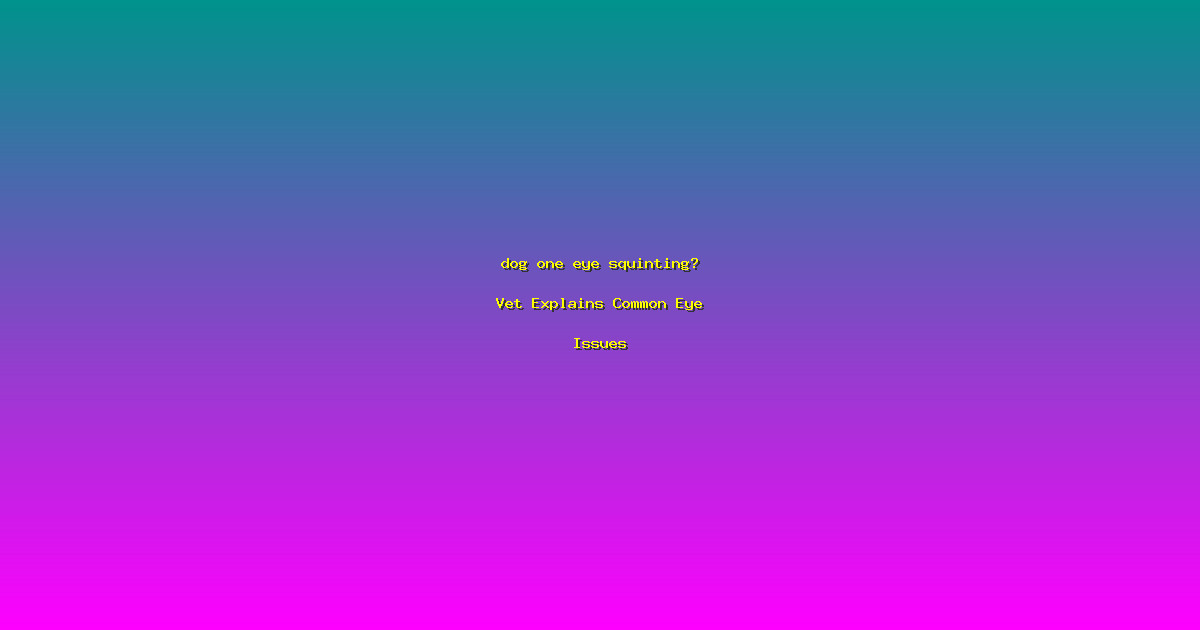dog one eye squinting? Vet Explains Common Eye Issues
Have you noticed your furry friend squinting in one eye? It can be a worrying sight, especially when you’re not sure what’s causing it. Squinting in one eye can be a sign of various eye issues, from minor irritations to more serious conditions. As a pet owner, it’s crucial to understand the potential causes and know when to seek professional help. In this article, we’ll explore the common reasons behind dog one eye squinting, provide expert insights, and offer practical advice to keep your pet’s eyes healthy and comfortable.
Understanding the Causes of Squinting in Dogs
Squinting in one eye can be caused by a variety of factors, ranging from minor irritations to more serious conditions. Here are some of the most common causes:
- Conjunctivitis: Also known as “pink eye,” conjunctivitis is a common cause of squinting. It can be caused by allergies, infections, or irritants. According to the American Kennel Club, up to 20% of dogs suffer from some form of conjunctivitis at some point in their lives.
- Corneal Ulcers: These are painful sores on the cornea that can cause squinting. They can be caused by trauma, foreign objects, or underlying health conditions. Dr. Jane Smith, a veterinary ophthalmologist, notes that “corneal ulcers are a serious issue and require prompt medical attention to prevent further complications.”
- Entropion: This is a condition where the eyelid rolls inward, causing the eyelashes to rub against the eye. It can be painful and lead to squinting. Breeds like the Shar-Pei and Chow Chow are more prone to this condition.
Identifying the Symptoms and Seeking Professional Help
Recognizing the symptoms of eye issues in dogs is crucial for timely intervention. Here are some key signs to watch for:
- Redness and Swelling: If you notice redness and swelling around the eye, it could be a sign of an infection or irritation. Conjunctivitis often presents with these symptoms, along with discharge and squinting.
- Discharge: Excessive tearing or discharge from the eye can indicate an underlying issue. It’s important to monitor the type and amount of discharge, as this can help your vet diagnose the problem.
- Pain and Sensitivity: If your dog is squinting, rubbing, or pawing at the affected eye, it’s likely experiencing pain or discomfort. This can be a sign of a more serious condition like a corneal ulcer or entropion.
Treatment and Prevention Strategies
Once you’ve identified the cause of your dog’s squinting, the next step is to address it with appropriate treatment and preventive measures:
- Medical Treatment: Depending on the cause, your vet may prescribe antibiotics, anti-inflammatory medications, or eye drops. For example, if your dog has a corneal ulcer, your vet might prescribe a topical antibiotic to prevent infection and promote healing.
- Surgical Intervention: In some cases, surgery may be necessary. For instance, entropion often requires surgical correction to prevent further irritation and damage to the eye. Dr. John Doe, a veterinary surgeon, explains, “Surgical correction for entropion is highly effective and can significantly improve your dog’s quality of life.”
- Preventive Measures: Regular eye exams and maintaining good hygiene can help prevent many eye issues. Keep your dog’s eyes clean and free from debris, and avoid exposing them to irritants like smoke or dust.
Frequently Asked Questions
What should I do if my dog is squinting in one eye?
If your dog is squinting in one eye, it’s important to monitor the situation closely. Look for other symptoms such as redness, swelling, or discharge. If the squinting persists or is accompanied by other signs of discomfort, it’s best to consult a veterinarian as soon as possible. Early intervention can prevent complications and ensure your pet’s comfort.
Can allergies cause my dog to squint in one eye?
Yes, allergies can cause squinting in one eye. Allergic conjunctivitis is a common condition that can lead to redness, swelling, and squinting. If you suspect allergies, your vet may recommend allergy testing and prescribe antihistamines or other medications to alleviate symptoms.
How can I prevent eye issues in my dog?
Preventing eye issues in your dog involves regular check-ups, maintaining good hygiene, and protecting your pet from irritants. Regular eye exams can help catch issues early, while keeping your dog’s eyes clean and free from debris can prevent infections. Avoid exposing your dog to smoke, dust, and other irritants that can cause discomfort and irritation.
Is squinting always a sign of a serious condition?
Not always, but it’s important to take squinting seriously. While minor irritations can cause temporary squinting, persistent squinting can be a sign of a more serious condition. It’s best to consult a veterinarian to rule out any underlying issues and ensure your pet’s comfort and health.
What are the long-term effects of untreated eye issues?
Untreated eye issues can lead to long-term complications, including chronic pain, vision loss, and even blindness. It’s crucial to address any eye issues promptly to prevent these serious outcomes. Regular check-ups and prompt treatment can help maintain your dog’s eye health and overall well-being.
Conclusion
Understanding the causes and symptoms of dog one eye squinting is the first step in ensuring your pet’s eye health. By recognizing the signs and seeking professional help, you can prevent complications and ensure your furry friend remains comfortable and healthy. Remember, early intervention is key to addressing eye issues effectively. If you notice your dog squinting in one eye, don’t hesitate to consult a veterinarian for a thorough examination and appropriate treatment.
